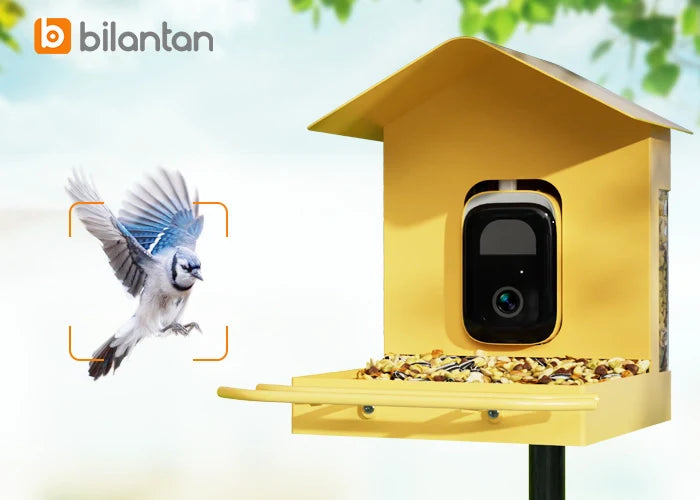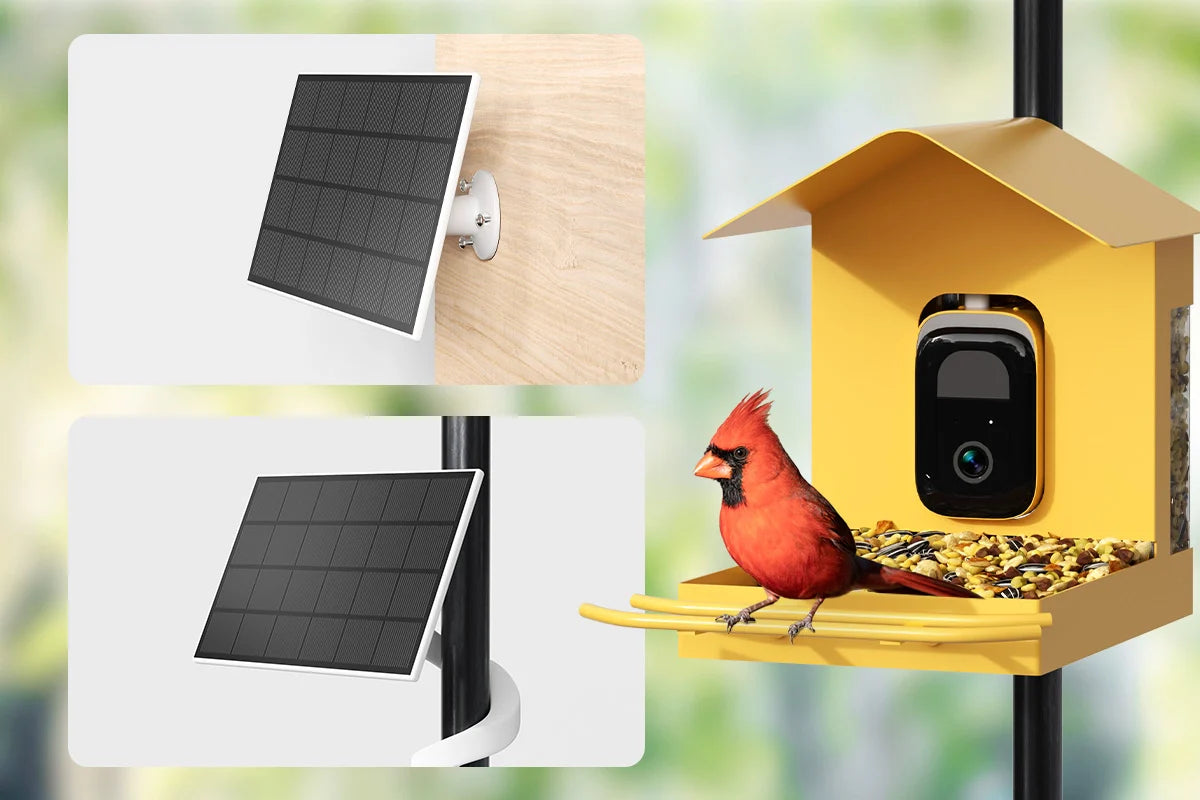The magic of a modern bird feeder doesn't begin when you open the app; it starts the instant a bird's shadow falls across its sensor. While a high-definition camera is essential, it is the sophisticated motion activation technology that transforms a simple camera bird feeder motion activation from a passive observer into an intelligent, responsive documentarian of nature. This critical feature is what enables Smart Wildlife Recording, ensuring that the device captures the action while conserving power, a principle central to Energy-Efficient Bird Watchin. Without intelligent triggering, a wildlife camera would record endless hours of empty footage—shifting shadows, falling leaves, and vacant perches—quickly filling storage and draining batteries. A Motion-Activated Bird Feeder Camera, however, operates with purpose. It remains in a low-power standby state until its sensors detect genuine activity, at which point it springs to life to capture high-quality photos or video clips. This selective recording is the cornerstone of an efficient and effective system, making it an indispensable tool for both casual bird lovers and serious naturalists. Brands like Bilantan have refined this technology to an art, creating devices that not only react to movement but intelligently analyze it. This article will explore how advanced motion detection elevates a standard camera bird feeder into a precise instrument for Smart Wildlife Recording.

The Brain Behind the Lens: How Intelligent Motion Activation Works
Beyond Basic Motion Sensors: The Problem of False Alarms
Early motion-activated cameras were notoriously simplistic. They detected any change in pixel values within their field of view, leading to a deluge of notifications triggered by passing clouds, swaying branches, or changes in lighting. This resulted in user fatigue and wasted storage, undermining the very purpose of Smart Wildlife Recording. Modern systems, like those developed by Bilantan, employ a more sophisticated approach. A Motion-Activated Bird Feeder Camera uses a combination of Passive Infrared (PIR) sensors and pixel-based analysis. The PIR sensor detects heat signatures and movement from warm-bodied animals, providing a reliable first filter that ignores most environmental false alarms. This initial trigger then wakes the main camera processor, which analyzes the image using algorithms designed to distinguish the specific size, shape, and movement patterns of birds and other wildlife from irrelevant motion. This two-stage process is crucial for accuracy. It ensures that the camera focuses its energy and storage on what truly matters: documenting the fascinating activity at your feeder. This intelligent filtering is the first step toward genuine Energy-Efficient Bird Watching, as it prevents the system from recording useless footage and squandering power.
Customizable Sensitivity and Detection Zones
A one-size-fits-all approach to sensitivity doesn't work for every garden. A feeder placed near a busy street might need different settings than one in a secluded backyard. High-quality camera bird feeder models address this through customizable sensitivity and detection zones. Bilantan's devices, for example, allow users to adjust motion sensitivity through a companion app. You can set it to high sensitivity to capture every small songbird or lower it to ignore smaller creatures and focus on larger visitors. Furthermore, the ability to define detection zones—specific areas within the camera’s view where motion will trigger a recording—is a powerful feature. You can mask out a busy sidewalk or a frequently moving tree branch, ensuring the Motion-Activated Bird Feeder Camera only alerts you to activity within the crucial area around the feeder perch. This level of control is a hallmark of a truly smart device, minimizing frustration and maximizing the relevance of your recordings.
The Benefits of a Strategic Approach to Recording
Maximizing Storage and Battery Life for Energy-Efficient Bird Watching
The most immediate and practical benefit of intelligent motion activation is the conservation of resources. Continuous video recording is a massive drain on both battery power and digital storage. A camera bird feeder that records 24/7 would require frequent recharging and a massive cloud storage subscription, making it an impractical solution for most users. By contrast, a Motion-Activated Bird Feeder Camera embodies the principle of Energy-Efficient Bird Watching. It only consumes significant power during the short periods when it is actively recording and transmitting a clip. This strategic operation can extend battery life from mere days to several weeks or even months on a single charge, especially when paired with a solar panel. Similarly, by only saving relevant clips, you avoid filling your Smart Wildlife Recording archive with hours of empty footage, making it easy to browse through and find the highlights you care about.
Creating a Curated Library of Wildlife Activity
Motion activation does more than just save space; it creates quality. Instead of a monotonous, day-long video file that you must fast-forward through, you get a curated collection of meaningful events. Each triggered recording represents a distinct visit or interaction at your feeder. This structure transforms the user experience. The Bilantan app organizes these motion-triggered events into a searchable timeline. You can quickly scroll through a day’s activity, seeing thumbnail images of each visitor. This makes it easy to answer questions like, "What was that unusual bird that visited at 3 PM?" or "How many times did the cardinal family come today?" This curated approach is the essence of Smart Wildlife Recording—it provides the data in a digestible, useful format that enhances your understanding and enjoyment.
From Trigger to Insight: The Workflow of Smart Recording
The process of a Bilantan Motion-Activated Bird Feeder Camera from detection to delivery is a seamless technological workflow:
1. Standby Mode: The device operates in a low-power state, with the PIR sensor actively scanning for heat and movement.
2. Initial Trigger: A bird lands on the perch. The PIR sensor detects its body heat and movement, sending a signal to wake the main camera and processor.
3. AI Verification: The camera captures a preliminary image. The onboard AI analyzes it to confirm the presence of a bird or animal, filtering out false triggers.
4. High-Quality Recording: Once verified, the system begins recording a high-definition video clip (e.g., 15-30 seconds) or captures a burst of photos.
5. Notification and Upload: An instant notification is sent to your smartphone. The clip is simultaneously encrypted and uploaded to the cloud server for permanent storage and later review.
6. Return to Standby: After the clip is saved, the system returns to its low-power standby mode, awaiting the next visitor.
This efficient cycle ensures that you are alerted to activity in near real-time while the system optimizes its energy use for long-term, hassle-free operation.
Experience the Difference of Intelligent Recording
A camera bird feeder is only as smart as its trigger. Motion activation is the feature that separates a basic camera from an intelligent wildlife monitoring system. It’s the technology that enables Smart Wildlife Recording and makes Energy-Efficient Bird Watching a practical reality for everyone. By choosing a Bilantan Motion-Activated Bird Feeder Camera, you are investing in a system that works smarter, not harder. You get all the captivating footage of your backyard visitors without the hassle of sorting through empty video or constantly recharging batteries.
Stop recording nothing and start recording nature. Visit Bilantan today to explore our range of intelligent, motion-activated camera bird feeders and discover how easy it is to create a curated documentary of your garden's wildlife.




Leave a comment
All comments are moderated before being published.
This site is protected by hCaptcha and the hCaptcha Privacy Policy and Terms of Service apply.